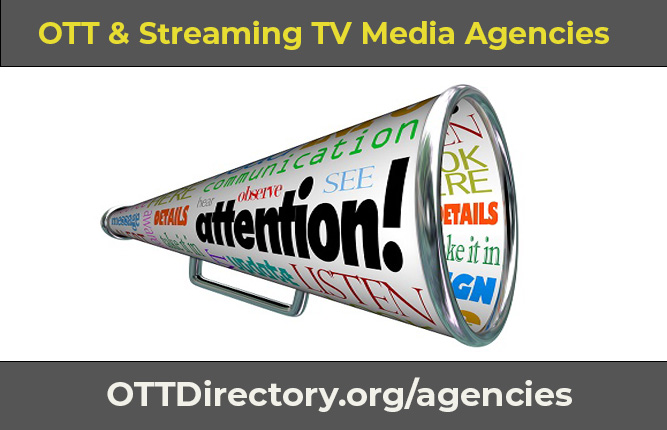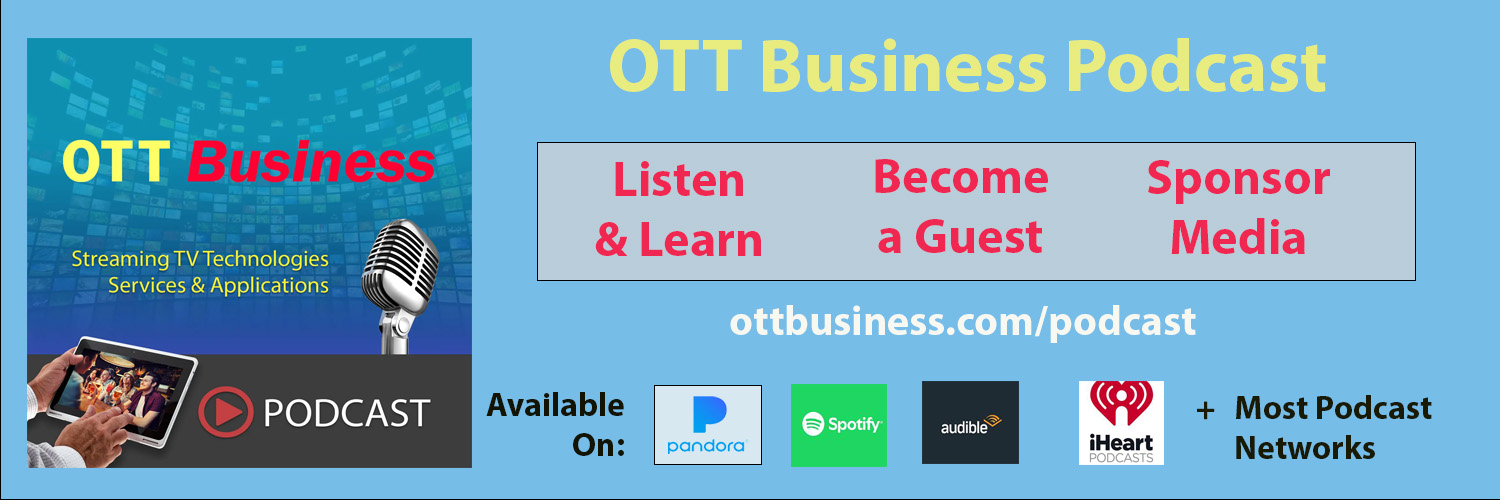OTT Media Agencies
 An OTT media agency collaborates with media equipment, platform or service provider companies to develop and execute comprehensive marketing and promotion strategies. This partnership typically begins with a thorough market analysis to identify key trends, target audiences, and competitive positioning. The agency then crafts a bespoke marketing plan that includes content creation, advertising campaigns, and media buying to ensure maximum reach and engagement. By leveraging their expertise in branding, the agency helps to refine the provider’s brand identity and messaging, creating compelling narratives that resonate with potential customers. Through continuous performance tracking and analytics, the agency optimizes campaigns to achieve the best possible outcomes, ultimately driving customer acquisition and retention. This approach ensures that the company effectively communicates its value proposition and stands out in the crowded OTT and streaming media industry.
An OTT media agency collaborates with media equipment, platform or service provider companies to develop and execute comprehensive marketing and promotion strategies. This partnership typically begins with a thorough market analysis to identify key trends, target audiences, and competitive positioning. The agency then crafts a bespoke marketing plan that includes content creation, advertising campaigns, and media buying to ensure maximum reach and engagement. By leveraging their expertise in branding, the agency helps to refine the provider’s brand identity and messaging, creating compelling narratives that resonate with potential customers. Through continuous performance tracking and analytics, the agency optimizes campaigns to achieve the best possible outcomes, ultimately driving customer acquisition and retention. This approach ensures that the company effectively communicates its value proposition and stands out in the crowded OTT and streaming media industry.
OTT Media Agencies
202 Comms PR – Provides PR and marketing services to technology companies in broadcast, media, and entertainment.
Bubble Agency – Specializes in PR and marketing communications for media, entertainment, and technology sectors.
Chris Pfaff Tech Media – Offers strategic media and marketing services for technology and media companies.
D. Pagan Communications – DPC – Provides comprehensive PR and marketing services for technology companies in broadcast and media.
Desert Moon Communications – Specializes in PR and marketing services for broadcast, media, and entertainment industries.
Grithaus Agency – Provides marketing and branding services to tech companies in media and entertainment sectors.
Jump PR – Specializes in PR and communications for companies in broadcast and digital media industries.
Liaison PR – Offers full-service PR and marketing solutions for tech companies in broadcast and media sectors.
Manor Marketing – Provides strategic PR and marketing services for technology companies in broadcast and media.
Mediaverse – Mediaverse provides digital asset management and content distribution solutions for the OTT and streaming TV industry.
MKM Marcom – Offers marketing communications and PR services tailored to media and entertainment technology.
Page Melia PR – Provides PR and marketing services for companies in media, broadcast, and entertainment tech.
Platform Comms – Offers PR, content marketing, and communications services for technology companies in media.
PR Comms – Specializes in PR and marketing communications for tech companies in broadcast and streaming media.
Radiance Communications – Provides PR and marketing solutions tailored to media and entertainment technology industries.
Radical Moves PR – Offers innovative PR and marketing services for companies in broadcast and digital media sectors.
Red Lorry Yellow Lorry (RLYL) – Specializes in PR, digital marketing, and communications for technology companies in media.
Thatcher and Co – Provides strategic PR and marketing services for companies in broadcast and media technology.
Wall Street Communications – Offers PR and marketing communications for technology companies in media and entertainment.
OTT Media Agency Key Capabilities
When working with OTT and streaming media companies, media agencies typically offer a suite of capabilities to develop effective media, marketing, and promotion programs. These services can include in-depth market analysis, content strategy and media production, campaign management and media buying, brand identity and messaging, media relations, crisis management, lead generation and customer loyalty programs.
Market Analysis
Conduct in-depth market research to identify trends, audience preferences, and competitive landscape. This is important because understanding the market helps in making informed decisions, staying ahead of competitors, and effectively reaching the target audience.
Strategy Development
Develop comprehensive marketing and media strategies tailored to the OTT and streaming TV market. Tailored strategies ensure that marketing efforts are aligned with the unique characteristics of the OTT market, leading to more effective campaigns.
Content Strategy
Develop content strategies that align with the company’s goals and resonate with target audiences. A well-crafted content strategy is essential for engaging the audience, building brand loyalty, and achieving business objectives.
Content Production
Create engaging and high-quality content, including videos, articles, blog posts, and social media content. High-quality content is crucial for capturing the audience’s attention, driving engagement, and establishing credibility.
Campaign Management
Design and manage advertising campaigns across multiple channels, including digital, social media, and traditional media. Effective campaign management ensures that marketing efforts are cohesive, targeted, and efficient, leading to better results.
Media Buying
Purchase advertising space and time on various platforms to maximize reach and effectiveness. Strategic media buying allows for optimal allocation of budget, ensuring the ads reach the right audience at the right time.
Brand Identity
Develop and refine the company’s brand identity to ensure it stands out in the competitive OTT and streaming TV market. A strong brand identity differentiates the company from competitors and builds trust with the audience.
Messaging and Positioning
Craft compelling messaging and positioning that highlights the company’s unique value proposition. Clear messaging and positioning communicate the company’s strengths and benefits, attracting and retaining customers.
Audience Engagement and Growth
Manage social media channels to engage with audiences, build communities, and promote content. Engaging with the audience on social media fosters a sense of community and loyalty, driving growth and retention.
Influencer Partnerships
Find and collaborate with influencers to expand reach and enhance credibility. Influencer partnerships can significantly amplify brand messages, reaching larger and more diverse audiences.
Metrics and KPIs
Define key performance indicators (KPIs) to measure the success of marketing and media efforts. Establishing KPIs is vital for tracking progress, identifying areas for improvement, and ensuring that goals are met.
Analytics and Reporting
Provide detailed analytics and reporting to track performance and optimize strategies. Analytics and reporting offer insights into campaign effectiveness, helping to refine strategies and maximize ROI.
Media Relations
Build and maintain relationships with media outlets to secure coverage and increase visibility. Strong media relations can lead to positive press coverage, enhancing the company’s reputation and visibility.
Crisis Management
Develop crisis communication plans to manage and mitigate any potential negative publicity. Effective crisis management protects the company’s reputation and ensures swift, coordinated responses to adverse events.
Lead Generation
Develop and implement strategies to generate leads and convert them into customers. Lead generation is essential for driving business growth and ensuring a steady stream of potential customers.
Retention Programs
Create programs to retain existing customers and reduce churn. Retention programs help maintain a loyal customer base, which is more cost-effective than acquiring new customers and crucial for long-term success.
TT Media Agency Glossary
- A/B Testing – A method of comparing two versions of a webpage or ad to determine which one performs better.
- Ad Spend – The total amount of money spent on advertising campaigns over a specified period.
- Attribution Modeling – The process of determining which touchpoints or channels contributed to a conversion or sale.
- Brand Equity – The value of a brand based on the perception of its name and identity in the market.
- Business to Business (B2B) – Transactions or marketing conducted between one business and another, rather than between a business and individual consumers.
- Byline Articles – Articles written bylined by a company’s executives or industry experts, published in relevant media outlets to establish thought leadership and expertise.
- Call to Action (CTA) – A prompt in a marketing message that encourages the audience to take a specific action, such as “buy now” or “sign up.”
- Campaign Flighting – The scheduling of advertising messages during specific periods to maximize impact and reach.
- Click-Through Rate (CTR) – The ratio of users who click on an ad to the number of total users who view the ad.
- Compound Annual Growth Rate (CAGR) – The mean annual growth rate of an investment over a specified period longer than one year.
- Content Marketing – The creation and sharing of valuable content to attract and engage a target audience.
- Cost Per Acquisition (CPA) – Measures the cost of acquiring a customer through a marketing campaign, often used in performance-based marketing.
- Cost Per Click (CPC) – The amount paid by an advertiser for each click on their ad.
- Cost Per Thousand Impressions (CPM) – Advertising cost metric that denotes the price of 1,000 advertisement impressions on a webpage.
- Customer Relationship Management (CRM) – Systems and strategies for managing a company’s interactions with current and potential customers.
- Designated Market Area (DMA) – A geographic area that represents specific television markets as defined by Nielsen Media Research.
- Earned Media – Publicity gained through non-paid promotional efforts such as media coverage or word-of-mouth.
- Geotargeting – The practice of delivering content or advertisements to users based on their geographic location.
- Gross Rating Points (GRPs) – A standard measure in advertising that quantifies impressions as a percentage of the target population, used primarily in TV advertising.
- Influencer Rating – A measure of an influencer’s ability to impact their audience’s purchasing decisions, often based on their reach, engagement, and content relevance.
- Integrated Marketing Communications (IMC) – A strategic approach to marketing that integrates various communication tools and channels to provide a consistent message.
- Key Performance Indicator (KPI) – Metrics used to assess the success of a campaign, such as website traffic, conversion rates, or social media engagement.
- Media Buy – The purchase of advertising from a media company, including the negotiation of price and placement.
- Media Mix – The combination of different advertising channels used to meet marketing objectives.
- Memorandum of Understanding (MOU) – A formal agreement between two or more parties outlining the terms and details of an understanding, including each party’s requirements and responsibilities.
- Non-Disclosure Agreement (NDA) – A legal contract between two parties to keep confidential information secret.
- Owned Media – Any web property that a company controls and owns, such as websites, blogs, or social media channels.
- Pay-Per-Click (PPC) – An advertising model where advertisers pay each time a user clicks on their online ads.
- Programmatic Advertising – The use of automated systems and algorithms to purchase digital advertising space.
- Search Engine Optimization (SEO) – The process of improving the visibility and ranking of a website or webpage in a search engine’s unpaid results.
- Sentiment Value – A measure of the public’s sentiment toward a brand or campaign, often derived from social media and other online interactions.
- Statement of Work (SOW) – A document that outlines the specific services, deliverables, and timelines that an agency will provide to a client.
- User-Generated Content (UGC) – Content created by consumers or end-users rather than by the company itself.

